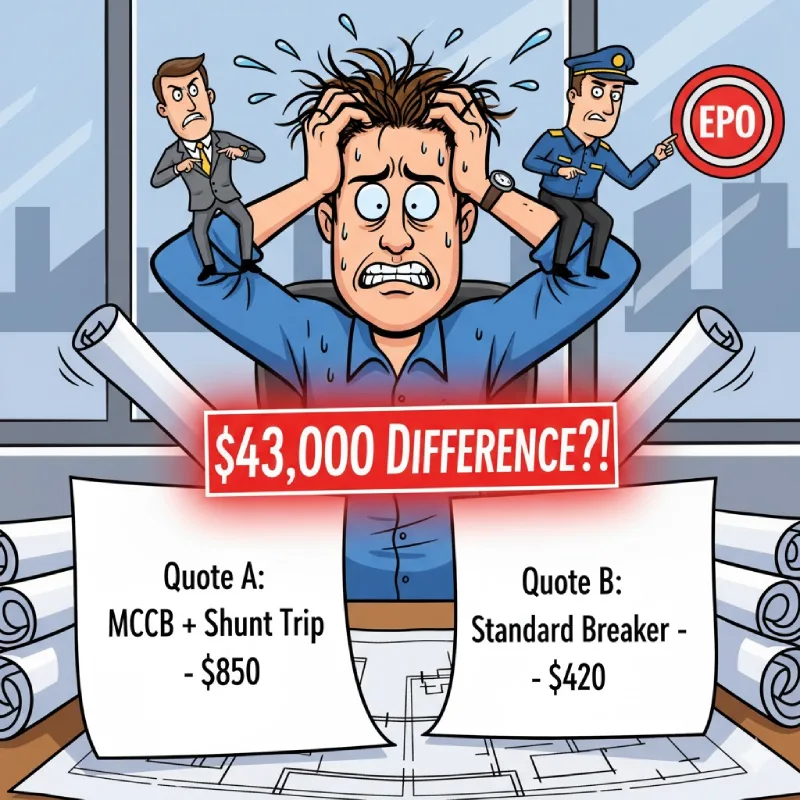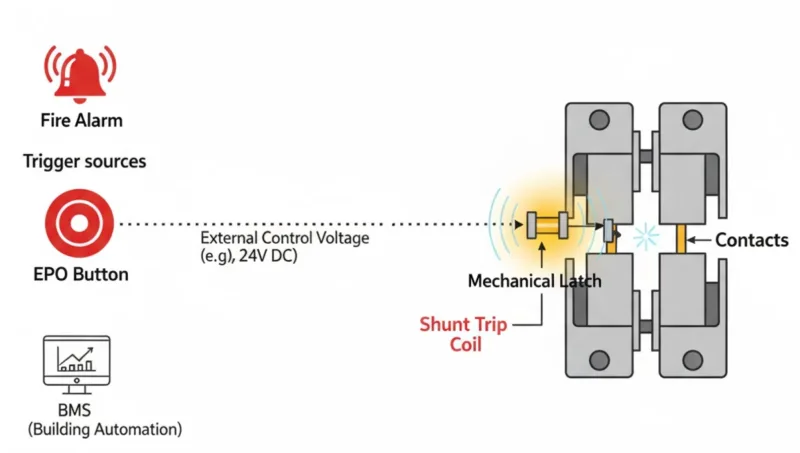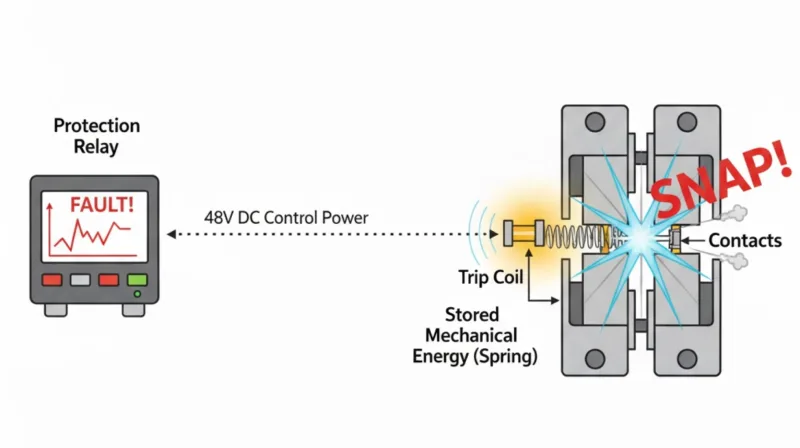When a $200 Accessory Becomes a $20,000 Mistake
You’re deep into the electrical design for a new manufacturing facility. The specs are clear: you need emergency power-off (EPO) capability for safety compliance, and robust overcurrent protection to prevent equipment damage. You send the breaker schedule out for quotes.
Two weeks later, you’re staring at two wildly different proposals. Vendor A specifies “MCCB with shunt trip accessory” at $850 per breaker. Vendor B offers “standard circuit breakers with integrated trip protection” at $420 each. Both claim to meet the requirements. The project manager is pressing you to explain the $43,000 price difference across 100 breakers.
Here’s the problem: you’re not entirely sure which specification is correct—or whether you actually need both mechanisms. Choose wrong, and you’re facing either a failed code inspection, an emergency shutdown system that doesn’t work when the fire alarm triggers, or an expensive retrofit that stops construction for two weeks.
So what’s the real difference between a shunt trip and a trip coil, and how do you specify the right protection without over-engineering (and overspending)?
Why Both Mechanisms Look the Same but Aren’t
The confusion is understandable. Both shunt trips and trip coils use electromagnetic coils to physically trip open a circuit breaker. Both make an audible “clack” when they operate. Both appear as small rectangular boxes on the breaker housing. But here’s the critical distinction that determines your entire protection architecture:
A shunt trip is an accessory that listens to external commands. Think of it as a “remote control receiver” bolted onto your breaker. When your fire alarm panel, emergency stop button, or building management system sends a signal, the shunt trip coil energizes and forces the breaker open—regardless of whether there’s an electrical fault.
A trip coil is the breaker’s internal “automatic safety mechanism.” It’s energized by protection relays that constantly monitor electrical conditions (overcurrent, ground fault, undervoltage). When the relay detects an abnormal condition, it energizes the trip coil, which then activates the breaker’s trip mechanism. No external signal required—the breaker is protecting itself and the circuit.
Kluczowy wniosek: Shunt trips respond to external safety systems; trip coils respond to internal electrical faults. You can’t substitute one for the other, and many applications require both.
The Answer Part 1: Understanding What Each Mechanism Actually Does
Shunt Trip: Your Circuit Breaker’s Emergency Override
A shunt trip is an optional accessory installed in a circuit breaker that allows remote or automatic tripping through an external voltage signal. When that external control voltage is applied to the shunt trip terminals, the coil generates a magnetic field that mechanically releases the breaker’s latch mechanism, instantly opening the contacts and cutting power.
Typowe zastosowania:
- Fire alarm integration (NEC 230.85 requires emergency disconnects in some applications)
- Emergency power-off (EPO) buttons in mechanical rooms, labs, or data centers
- Building automation systems that shut down equipment during off-hours
- Safety interlock systems that de-energize equipment when guards are opened
The Critical Specification Detail: Shunt trips require an external voltage source, typically 120V AC, 240V AC, or 24V DC depending on the model. This voltage must come from a reliable source—often the fire alarm panel’s auxiliary contacts or a dedicated control power supply.
Pro-Tip #1: The biggest specification mistake engineers make is assuming a standard thermal-magnetic trip can replace a shunt trip for fire alarm integration. It can’t—and code inspectors will red-tag it immediately. NEC and local fire codes explicitly require remote tripping capability for certain applications, which means a shunt trip accessory is non-negotiable.
Trip Coil: The Breaker’s Internal Protection Enforcer
The term “trip coil” refers to the electromagnetic coil within a circuit breaker that executes the trip function when energized by a protection relay or the breaker’s internal logic. In low-voltage breakers (like typical MCCBs), the “trip coil” function is usually integrated into the thermal-magnetic or electronic trip unit. In high-voltage and industrial power circuit breakers, the trip coil is a distinct, separately-powered component.
How It Works: Protection relays continuously monitor current, voltage, and other parameters. When an abnormal condition is detected—an overcurrent that exceeds the pickup setting, a ground fault, or an undervoltage event—the relay closes a contact that energizes the trip coil. The energized coil releases the breaker’s stored mechanical energy (usually a charged spring), which rapidly opens the contacts.
Typowe zastosowania:
- Overcurrent protection (short circuit and overload)
- Ochrona przed zwarciem na ziemię
- Undervoltage or overvoltage protection
- Differential protection in transformer or generator circuits
- Motor protection schemes integrated with protection relays
The Critical Specification Detail: Trip coils in high-voltage breakers typically require DC control power (125V DC or 48V DC from a station battery). This ensures the breaker can trip even if AC power is lost during a fault. Using the wrong voltage will either fail to trip the breaker or damage the coil.
Pro-Tip #2: For emergency shutdown systems, shunt trips must be powered from a separate, reliable source—not the same circuit they’re protecting. If a fire damages the main service, you need the shunt trip to still function.
The Answer Part 2: The Three-Step Selection Framework
Now that you understand the fundamental differences, here’s how to specify the right protection mechanism for your application.
Step 1: Map Your Protection Requirements to the Correct Mechanism
Start by asking: “What needs to trip this breaker, and why?”
Specify a Shunt Trip if you need:
- Remote manual tripping (EPO buttons, pull stations)
- Integration with fire alarm or life safety systems
- Automatic shutdown based on non-electrical conditions (smoke detection, gas leak, temperature)
- Building automation control (scheduled shutdowns, demand response)
Use the Integrated Trip Coil/Protection System if you need:
- Overcurrent protection (always required)
- Ochrona przed zwarciem na ziemię
- Protection relay coordination with upstream/downstream devices
- Motor protection or transformer protection schemes
Real-World Example: A data center requires both. The UPS feeds critical server racks through a 400A MCCB. The breaker must have:
- Electronic trip unit (internal trip function): Provides overcurrent and ground fault protection with adjustable time-current curves
- Shunt trip accessory: Wired to the EPO button at the exit door, as required by NFPA 75
Total cost: $1,240 per breaker. If you omit the shunt trip and rely only on overcurrent protection, you fail the fire code inspection—and pay for the breaker twice.
Step 2: Understand the Control Architecture and Voltage Requirements
For Shunt Trips:
You must design the control circuit that will energize the shunt trip. Critical considerations:
- Voltage matching: The shunt trip coil voltage must match your control power source. Common options are 120V AC (from fire panel), 240V AC (from control transformer), or 24V DC (from safety PLC).
- Power source reliability: For life safety applications, the control power must be on emergency backup. Don’t power a fire alarm shunt trip from the same panelboard it’s protecting.
- Wiring method: Shunt trip control wiring is often considered “Class 1” wiring under NEC, requiring specific installation methods.
- Momentary vs. sustained: Most shunt trips require only a momentary pulse (0.1-1 second) to trip. Sustained voltage can overheat the coil.
Pro-Tip #3: Always verify the shunt trip coil’s power consumption (typically 10-50VA). If you’re wiring 20 shunt trips to a single fire alarm panel, ensure the panel’s auxiliary relay contacts are rated for the total inrush current. Otherwise, the relay contacts will weld closed—and your entire emergency shutdown system fails.
For Trip Coils (High-Voltage Applications):
Industrial and high-voltage breakers with separate trip coils require:
- DC control power: Typically 125V DC from a battery bank (station battery). This ensures trip capability even during a total AC power loss.
- Trip coil supervision: The control circuit should monitor trip coil continuity. A broken wire means the breaker won’t trip on command—a dangerous hidden failure.
- Proper relay coordination: Protection relays must be programmed with correct pickup, time delay, and curve settings to energize the trip coil at the right moment.
Step 3: Specify Correctly and Avoid the Common Pitfalls
When writing your specifications or reviewing shop drawings, ensure:
For Shunt Trip Applications:
- Clearly state: “Circuit breaker shall include factory-installed shunt trip accessory, [voltage], suitable for remote tripping from fire alarm system.”
- Specify the control voltage and verify it matches the available control power.
- If the breaker is in a harsh environment, specify the shunt trip’s environmental rating (standard accessories may not be suitable for high-vibration or corrosive environments).
- Include wiring details: “Shunt trip control wiring shall be routed in dedicated conduit, separate from power conductors.”
For Trip Coil Applications (HV Breakers):
- Specify the DC control voltage: “Circuit breaker shall include trip coil rated for 125V DC station battery.”
- Require trip coil supervision circuitry.
- Coordinate with protection relay settings—specify the relay model and confirm it’s compatible with the breaker’s trip coil impedance.
Pro-Tip #4: When retrofitting older installations, double-check the control voltage. I’ve seen engineers order 120V AC shunt trips for panels that only have 240V AC control power available. The result? An emergency shutdown system that doesn’t work, discovered only during commissioning—after the walls are closed up.
The Bottom Line: Know What You’re Protecting Against
By understanding that shunt trips and trip coils serve fundamentally different protection functions, you can now confidently specify the right mechanism:
- Shunt Trip = External Command Response: Use for emergency shutdowns, fire alarm integration, and remote control
- Trip Coil = Internal Fault Protection: Use for overcurrent, ground fault, and other electrical abnormality detection
- Many Applications Require Both: Don’t assume one replaces the other
Following this three-step framework, you will:
- Avoid costly specification errors and project delays
- Meet electrical and fire code requirements on the first inspection
- Design emergency shutdown systems that actually work when needed
- Correctly allocate your protection budget without over-engineering
The next time you’re staring at competing quotes with a $400 price difference per breaker, you’ll know exactly which specification is correct—and be able to defend your decision to the project manager, the authority having jurisdiction, and the mechanical contractor who’s wondering why “the breaker needs all these extra wires.”
Need to specify circuit breakers with shunt trips or complex protection schemes? Start by mapping your protection requirements (Step 1), then verify your control voltage architecture (Step 2), before finalizing the equipment schedule. And remember: a $200 shunt trip accessory specified correctly is far cheaper than a $20,000 retrofit after failing inspection.






